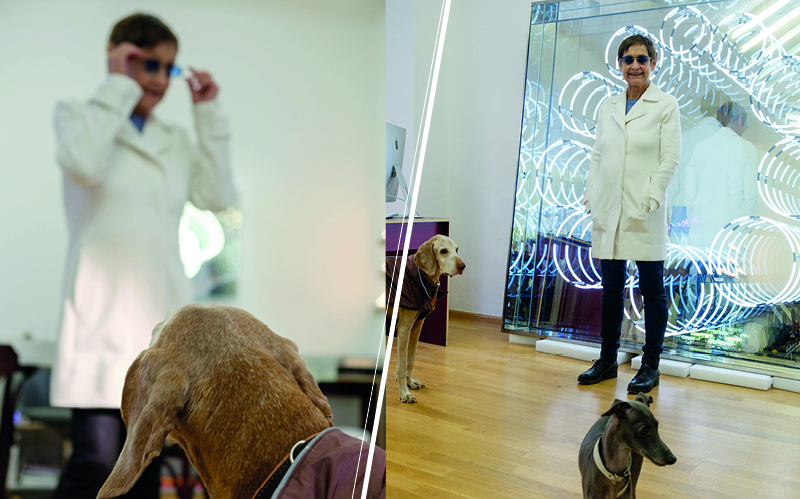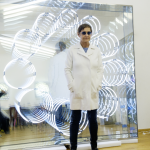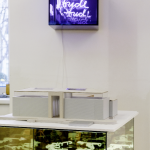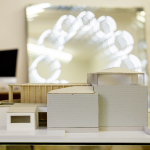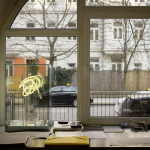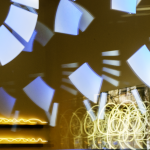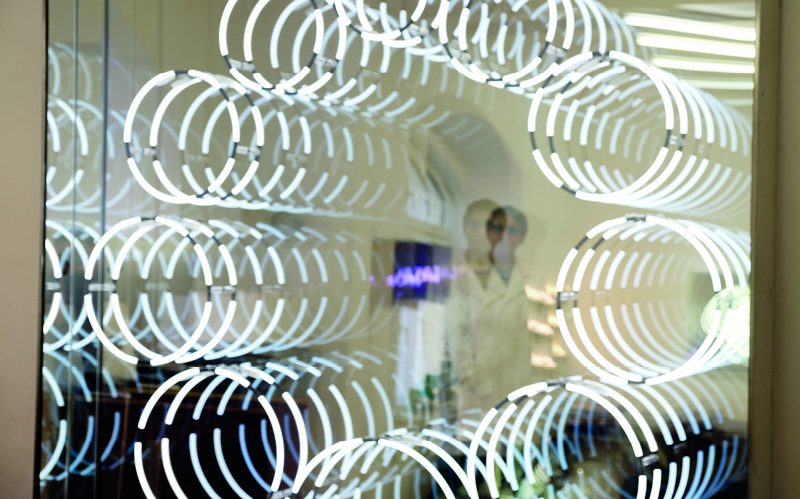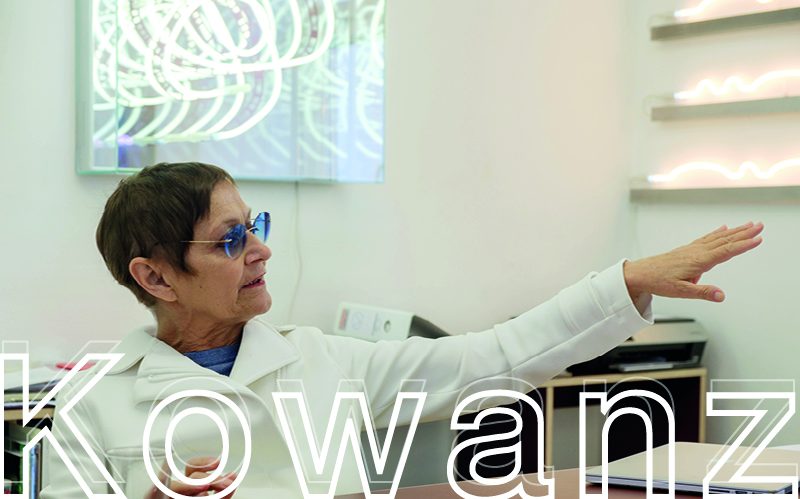
Brigitte Kowanz takes a distinctive position regarding her international ranking in the most recent history of art. Since the 1980s, light as a medium, which she explores in relation to space and in combination with signs, codes and language, has been at the center of her work. Light serves Kowanz as both a medium of transgression and of specification in order to question conventional concepts of image and painting in creating a new, integral relationship between the work, space, and the viewer. In conjunction with Erwin Wurm, Brigitte Kowanz will make use of the Austrian Pavilion at this year’s Venice Biennale.
by GABRIEL ROLAND
Mrs Kowanz, your father was a soccer player, how did your contact with art come about?
I have a brother, who is about five years younger than I and who studied at the University for Applied Arts Vienna (“Applied”). Therefore I experienced an intense early confrontation with art. The affinity has always existed, but the direct exposure to exhibitions, to the “Applied”, and to contemporary art took place via my brother.
Was there a specific point in time when you perceived art as more than simply a vocation, had this perception occurred before you began your studies?
It was always very clear to me that it would absorb my entire interest. In the 1970s, it was not a given, that one would be able to make a living from one’s art. We had a completely different estimation than have the more recent generations, but we provided a very practical example for living. At the time artists had by necessity, to have a part-time or even full-time job, that may have included teaching art. Very few artists were able to work freely and independently. When I was a student, I worked on varied productions, created graphic and book design, and assisted in the presentation of exhibitions.
How has the situation for artists changed compared to that time?
The market has changed enormously. In the 1970s, there were basically only two galleries in Vienna: the Galerie nächst St. Stephan and Galerie Grita Insam. There was the Museum of the 20th Century and Galerie Krinzinger in Innsbruck. That was it.
So it was a change that had begun in the market not in the artists’ self-understanding?
I don’t think it can be separated. As a young artist one goes into galleries and one jobs in the studios of established artists. This is the way one gains experience. Of course there is the desire to be able to support oneself from one’s art – but the reality is for the most part, different. Yesterday, a student expressed to me that she doesn’t want to work for others and that at the age of thirty she must be able to support herself from her art. That’s very optimistic, unrealistic, and unfortunately happens very rarely.
But isn’t it correct to say that today, an artist under the age of thirty can be both artistically and financially successful?
This is true only for the very few and often appears different than it actually is. Artistic and financial success are two quite different things. I was really successful very early – with my partner at the time Franz Graf. And yet we always had to work part-time jobs on the side. We exhibited at the Biennale and participated in the Triennale, and in 1981 Kaspar König invited us to show our work in the exhibition “Westkunst”. We took part in large exhibitions. But the interest of the market lay elsewhere.
Mrs Kowanz, not only has the market changed, but also art education. Artists are in part educated in the practicalities of how to sell their work professionally. Was that the case in your course at the University of Applied Arts Vienna?
That aspect of study has certainly received a greater emphasis in recent times. As far as my students are concerned, their interaction with reality is of vital importance to me. At the time of my studies, we were quite naïve, really had no idea. The subject wasn’t addressed at all by the professors. I try to approach projects with my students in such a way that they learn the various phases and procedures involved in competitive projects, and of course we speak of marketing strategies; but first the work must have substance, the remainder is assimilated in the procedure.
What qualities does a student require to make a living from their art, if not at age thirty then perhaps forty or forty–five?
The artistic potential must be clearly evident, but other capabilities must be developed. It’s essential to have a familiarity with social media, an ability to communicate and to be well focused. In addition, it is vitally important to know that in the main, it is difficult to make money from art. In Austria there are only a few artists who are able to support themselves from their art, and furthermore, it is noticeable, that very few women are among them.
If artists become the communicators how does that change the role and image of curators?
Curators still play an important role. Artist, gallery owner, and curator – each covers a different aspect of communication. They complement each other. The exchange with galleries and curators has always been very important to me.
In the meantime, many artists take an interest in curating exhibitions.
I also like to do it occasionally. It is exciting to develop concepts with the work of others. We just like to create exhibitions, preferably with our own work but also with the work of others. Creating exhibitions is simply the best there is! The young have off-spaces that serve as both studio and gallery. I think that is very important and belongs to the ability of an artist to moderate and communicate.
Together with your former partner, Franz Graf, you used to make many drawings, at what point did you begin to explore light?
I have always done drawings, but even in the first installations with my former partner Franz Graf, I had begun to include light. In the beginning we were concerned with color spaces, followed by black light in connection with fluorescent colors; painting became more present. After our separation, Franz continued with drawing and I continued pursuing light. During my studies, I worked with experimental film, video, and photography where light plays a crucial role.
How does your approach to light compare to that of other artists who use light, such as Dan Flavin or James Turrell?
Dan Flavin created his installations with conceptual rigor as abstract forms. James Turrell creates spaces that operate with the illusion of surface. In my work I try to create spatiality, that is three-dimensionality, through the layering of transparent surfaces such as glass or reflecting surfaces generating new virtual spaces by means of light.
One can appreciate this in the case of photographers and painters, but how do you approach a new piece of work as a light artist?
Over the years, I have collected a treasury of experience (points to her head). But it always comes differently. Sometimes I imagine something and then something better results – or it may be the other way around. My work always begins with a drawing, followed by ideas of how these lines can be transformed into light, how they reflect on surfaces, and what images emerge in the process. This is where computer work comes into place.
One gains the impression that you follow an explorative, almost scientific approach.
Yes, it is certainly explorative research. My way of proceeding is actually phenomenological. There is always an initial idea but most things must simply be tried out and developed as in a laboratory. One notices with each subsequent work what is being discovered and the resultant new interests.
Do you want to trigger or cause something specific in the viewer?
Light is the prerequisite for seeing and perceiving. Light in itself, however, can only be perceived in connection with material. Light is energetic and dynamic, it is a carrier of information. Light can be and can not be. This on and off opens the possibility to inform with light. Light is expansive and elusive, it never remains the same – light is a metaphor for life.
As a viewer one often feels almost drawn in by your works, is that intentional?
The viewers meet themselves in reflection while standing inside the object. It is more than a typical mirror image. In these works viewers find themselves in virtually generated rooms in which I try to confront them with philosophy, language, and acute socio-political issues. This is an important phenomenon and is accompanied by aspects of natural science. The observation and presence of light is actually something very elementary that everyone can experience day by day.
Are there people who inspire you, perhaps not only in your work, but in your personal life?
There are a number of people, who I greatly appreciate. From my time as a student: Oswald Oberhuber was a very important figure, as were Peter Weibel and Joseph Beuys. I am interested in philosophy. It is something that I constantly grapple with just as much as with natural science.
How does it feel when one is called to represent one’s country in one of the most important international art exhibitions?
It was a very big surprise, because I had no longer expected it, and actually I was no longer concerned about it (laughs), so this enabled me to feel joy about it. Gradually I am becoming aware that this nomination entails many positive as well as rather difficult aspects.
Mrs Kowanz, some time ago we also spoke with Heimo Zobernig about Venice and he said that years before it actually occurred, he had explored the potential of the pavilion, in the event he may one day be called; did you do this too?
No, not at all! I usually make things only when they are really acute. But one certainly does play with the thought. To be able to be involved in such a big event is surely what every artist wishes for. But I have never pondered about what I would do concretely beforehand.
Was the combination with Erwin Wurm the curator’s concept or was it your idea?
The curator, Christa Steinle, proposed the two of us because we both work with the themes of temporality and materiality. At the core of the project is how we deal with temporality and materiality: for my part I had turned away from classical media very early and had begun to experiment with light.
At first glance Erwin Wurm and you seem to be an unlikely pairing.
This has frequently been pointed out to us, but I must honestly say that I prefer to exhibit with someone whose work differs significantly from mine. I believe an exciting confrontation between our two contributions will emerge.
How is it when one works on something like this with someone else? Do you make arrangements or discuss things together? Do the contributions correspond?
Our individual contributions are entirely independent of each other. We are certainly in contact about everything that happens around the event. However, the works stand for themselves but will correspond with each other. I notice more and more that the curator’s decision to bring these two positions together was very insightful.
In the beginning, was there a point at which, as in so many other cases, you doubted whether the project would function?
It was certainly clear that it would be more difficult to have the pavilion on one’s own. It is already very small for just one artist. It appears quite big but it isn’t really. It measures 180m² and was built for a very different art. I’ve known Erwin Wurm for a very long time. We were at the Biennale in São Paulo together, so I was not concerned.
Do you work differently knowing that your work will be exhibited in the pavilion?
I always reflect very much on the spaces and their context. And Venice is anyway a very special situation! Because the pavilion would be too difficult for two, they’ve built a new annex, which is directly connected. I plan a large installation that’ll show new aspects in form and content.
Do you see the pavilion’s concrete architecture rather as a challenge or as a ‘bon chance’?
Very many artists have related to the pavilion. The new annex has a “white cube” quality to it and is an ideal exhibition space; I am actually very happy about it. My work would have functioned equally well in the pavilion’s historical part, but I believe the annex is the better solution.
Your works often contain inscribed words. Is there a central message for Venice?
The conception is complete, however I don’t want to reveal it just yet. It won’t be very long now; it’s not a good idea to let the cat out of the bag too soon.
What about the contributions from other countries? Do you take notice of what other artists are doing?
Not at all! In the case of some pavilions I know who is exhibiting. I was certainly interested in that, but not in what will be shown. There hasn’t really been any interaction. I assume it will happen on location.
What comes after Venice?
I would like to know that myself! There is a lot that I have to do but I must see whether the attention will increase. At the moment interest in my work is stronger than before. Venice has certainly made a difference.
___
Gabriel Roland is an editor of Collectors Agenda,
www.collectorsagenda.com

